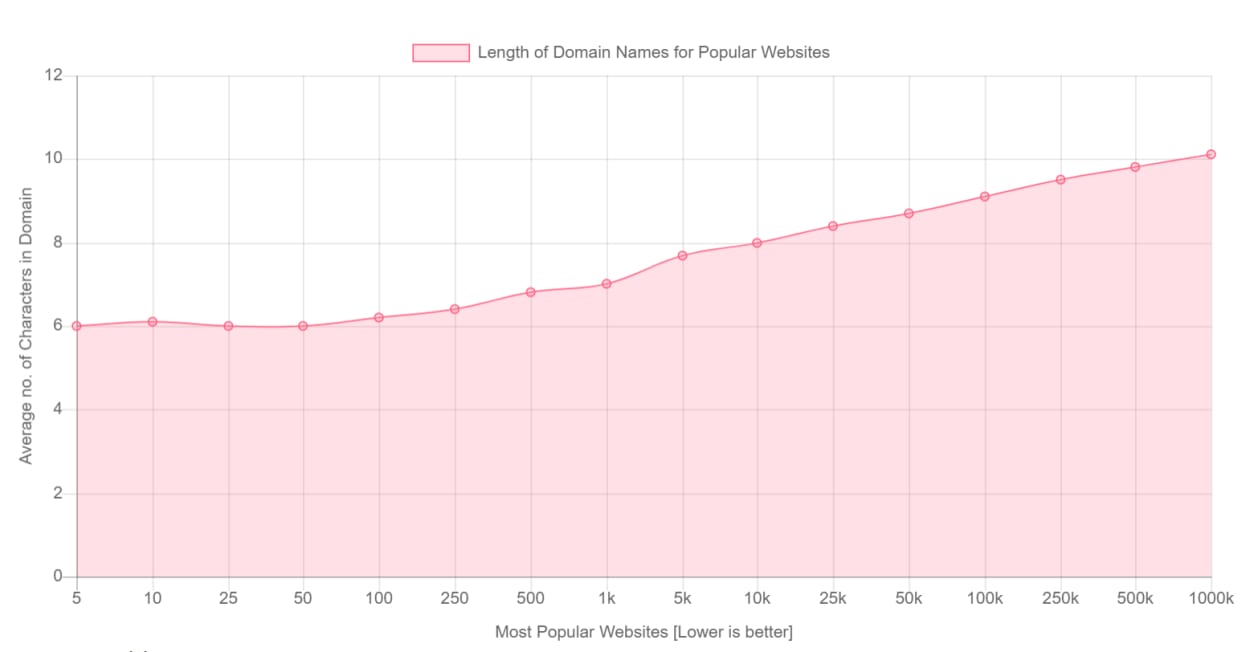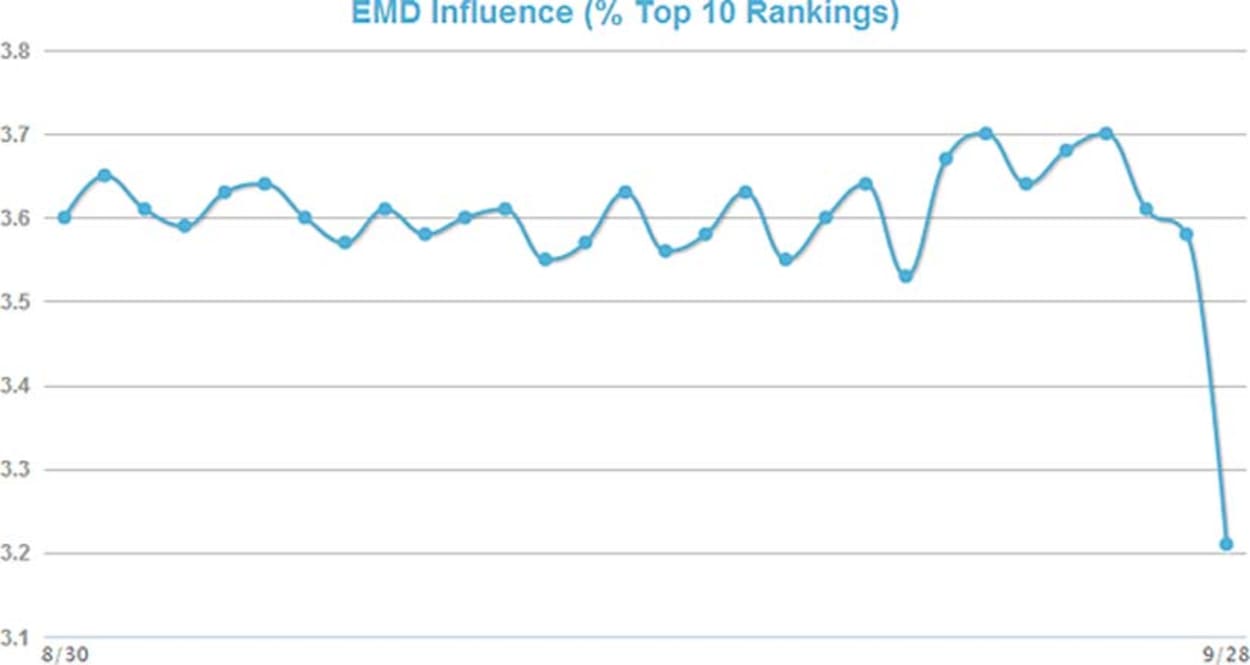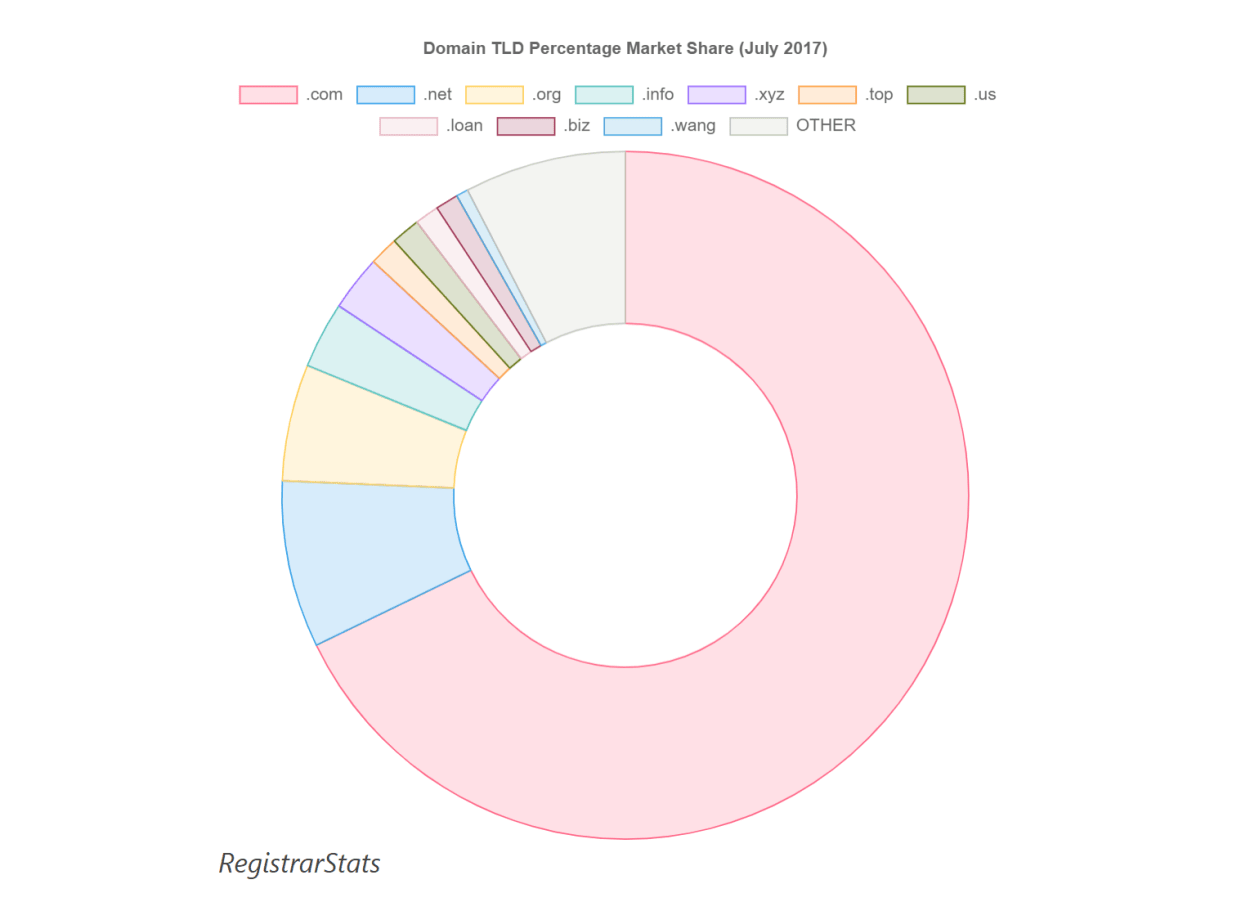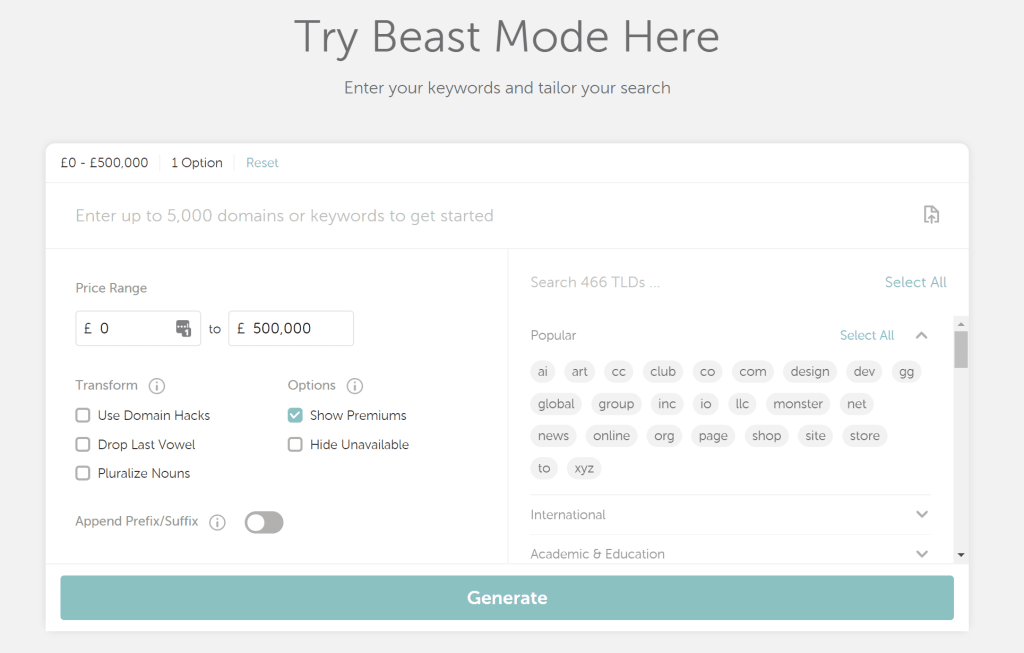It is crucial to choose a good domain name at the outset. And for good reasons:
- It’s essential to make an excellent first impression. Often your domain will be the first thing they see, whether as a link on another site, social media, advert, or just in Google.
- Your domain choice can affect SEO, although this should not be your primary consideration. The effect on your ranking will likely be minuscule in the long term.
- Your domain can define your brand and aid with brand recognition.
Once you have decided on your name for your website, you will need to register your new domain with a domain registrar or even get it free with web hosting.
What makes a Good Domain Name?
Here are our top tips for creating a great domain name:
Make it Brandable
A brandable domain is usually referred to as being a non-keyword name with no specific descriptive meaning.
A brand name can allude to the product, but they do not tend to spell it out or at least look overly keyword orientated.
This automatically excludes domains such as:
- the-bike-shop.com
- bik3shop.com
- bestbikeshopsellerintheworld.com
But the following may be great choices:
- cycleheaven.com
- trekbikes.com
- thewebmaster.com
Here are six common characteristics that make up a good brandable domain:
- #1. They are relevant - They relate to the product or service sold with a complementary or implied meaning.
- #2. They are unique - They are very distinct from your competition. They may be intriguing or have some unique personality.
- #3. They are memorable - They are easy to remember and recall.
- #4. Credible - They inspire trust and look professional. For example, they avoid the words “best,” “top,” and “honest” in the domain.
- #5. Brief - They consist of one or two words. This is to help aid memorability but also makes it easier to type the domain or branded search in browsers.
- #6. User-friendly - They are easy to spell, have no confusing words (ate vs. eight), do not use numbers as digits, random abbreviations, or jargon, and naturally read as multiple words rather than jargon.
I’ll touch on a few of these points again later.
Top tip:
You should consider using your name if you are creating a personal blog, online resume, or personal website.
For example:
- jonathangriffin.me
.me TLDs can be a great option for this.
Keep It Concise
Making your domain name short makes it easier to type, say, remember and share.
Back in 2009, Gaebler carried out research on the top one million domains (according to Alexa) and found a direct correlation between popularity and domain name length. We have produced a graph of the results below:

Of course, this does not necessarily mean there is a causal link. There are plenty of reasons why the most trafficked websites have shorter domains. Some reasons are as follows:
- Wealthy websites can afford short domains (3 or 4-character domains can be worth millions)
- Wealthy websites have a bigger marketing budget enabling them to generate more traffic.
I think the length of a domain does not matter (provided the length is reasonable) so long as the basic branding principles are there.
Namely, it is easy to type, say, remember and share.
A great example is that this website is 12 characters long but is very easy to remember. “The Webmaster,” flows off the tongue, uses the main .com TLD, and has a descriptive meaning related to the topics discussed on this website.
Make it Easy to Type
When registering your domain, you should ensure it is easy to type.
Such a domain usually has the following characteristics:
- #1. Easy to spell
- #2. Easy to enter into the address bar
- #3. Does not use awkward, odd, or misspelled words
- #4. Does not use hyphens or numbers
Essentially, it is not very good if you have to spell out your domain for it to be understood.
One example of a well-known brand that made a mistake was the social network flickr.com, launched in 2005. Just four years later, the company acquired flicker.com for a significant sum of money to redirect users that misspelled the domain to the correct one.
One lesson from the Flickr example is that if your domain is easily mistyped, it may be worth acquiring and redirecting those domains.
Make it easy to Pronounce
There are two reasons why you should make your domain easy to pronounce:
- #1. Processing fluency - This is a cognitive bias humans have that makes it easy to remember things that are easy to say or think about.
- #2. The rise of Voice Searches - With the rise of Google voice searches and Voice Assistants such as Siri, Cortana, and Alexa, it is worth ensuring that your domain can be easily found using these search methods.
Domains containing verbally confusing words such as numbers or hyphens may be confused by voice assistants and users alike.
But it goes a little further than this. If you own a global brand, you may also want to consider how your domain may be pronounced by your users who speak a foreign language.
Consider Using Broad Keywords in your Domain
Wait a second. Doesn’t this conflict with what I said about branded domains?
In a way, possibly.
As long as you are careful when choosing your domain not to make it too generic, one broad keyword or related keyword that alludes to what you are selling is good.
Using keyword exact matches was all the rage a couple of years ago. Still, the Exact Match Domain or EMD update that Google rolled out in September 2012 significantly reduced their benefit for Search Engine Optimization (SEO).
Early data from just after the release of the EMD Update showed a significant fall in rankings for those sites, although there is an indication of some minimal benefit.

That being said, when users link to your website using a naked URL (thewebmaster.com/domain-articles/how-to-choose-a-domain-name/), the domain and URL itself will act as the anchor text. This will be the visual queue to tell readers what type of website and page may be at the other end of that link.
We don’t think you need to worry about keywords in your domain, but having a general or topical keyword may give you that perfect domain name for ranking in search engines.
You can always add a few keywords in the URL for individual pages. This has been shown to have some small benefit for ranking in the search engines, especially if added to the beginning.
Think Long-Term
One of my favorite tips for choosing the best domain is thinking long-term.
I see so many webmasters choose domains like “bestbikes.com” or “grilledchickendallas.com” only to realize in a few years’ time that they want to sell cars or grilled chicken in New York. These examples are bad for many other reasons, but they also make good examples.
Changing a domain in the future can be a lot of work and result in lower Google rankings (at least for a time). Changing branding can also be expensive, for example, signs, logos, website design, hiring web developers, SEO specialists, etc.
Just take “thewebmaster.com”. I am not restricted to any specific area relating to websites that I can cover. Anything related to websites goes from SEO and digital marketing to hosting. In essence, it is future-proof. That is what you should be aiming for. Flexibility.
Check Availability on Social Media websites
Before finalizing your domain name, it is worth checking to see if that name is available on social media sites. You could lose business to rivals if someone else has your social profile.
A successful brand usually has the same name across all social networks, making them easy to find by your customers and other visitors and providing an appearance of professionalism.
The best way to check if your name is available on a specific social media site is to use a tool like KnowEm.
Use the .com domain extension, if possible.
When searching for an available domain name, it may be tempting to use a .net, .shop, .biz .rocks, or some Top Level Domain name extension other than a .com TLD.
Before going this route, ask yourself whether users remember the TLD. I bet you that many don’t.
According to RegistrarStats, over 67.8 percent of all domains use the .com domain name extension. I’ve calculated the percentage share for the ten most popular domain TLDs and created a chart below:

The favorite top-level domains used by webmasters are com, net, and org. They are sold by most domain registrars and hosting providers.
However, suppose you want a premium domain (something a little more special and expensive) or one of the many new domain extensions. You may need to register it with a more specialist domain registrar, such as GoDaddy or Namecheap.
A great alternative to a .com if your intended audience is restricted to one country (i.e., you are a local business) is to use country codes or ccTLD. An example is .us for the United States or .uk for the United Kingdom. Please be aware that Google treats these as a country-specific domains and will only be listed in the relevant country’s Google Search.
I’ve created a simple step-by-step guide on registering a domain with GoDaddy or Namecheap here.
Use Domain Name Generator Tools to Gather Ideas
Using domain name generation tools can help you choose the best domain by providing valuable ideas that you can compare against my previous tips.
You can find a complete list of the best domain name generators here, but we have included a summary of our favorite below.
Namecheap’s “Beast Mode.”
- Domain Hacks
- Prepend \ append keyword
- Domain availability
- Exclude premium domains
- Search by category
- Share your search with colleagues or friends
- Import \ export options
- Search up to 5000 domains or keywords at once
What to Avoid when Choosing your Domain Name?
Avoid Hyphens and Numbers
Numbers and hyphens can make your domain difficult to spell, pronounce and remember.
Take a look at these examples:
- number1cycles.com
- best-cycle-store-in-the-world.com
Is that a “one” or an “L”? If you remember it, would you type “numberonecycles.com” because you forgot it was spelled using a number?
What about the hyphen-laden domain? You might remember it as “best cycle store in the world dot com,” but would you remember the hyphens?
I know I wouldn’t.
The simplest way is to just stick to letters.
Domain names that infringe a Trademark
One of the most overlooked and potentially expensive mistakes you can make is ensuring that any domain you choose does not infringe on someone’s trademark, business name, or brand.
I’m no trademark law expert (I was a UK Property Lawyer for many years), but after a bit of research, I found a great article laying out the basics of US trademark law.
The main principles are:
- Names identifying the source of products or services in the marketplace are trademarks.
- Trademarks that are clever, memorable, or suggestive are protected under federal and state law.
- Trademarks that are descriptive and have achieved distinction through sales and advertising can be protected under federal and state law.
- One trademark legally conflicts with another when using both trademarks is likely to confuse customers about the products, services, or their source.
- In case of a legal conflict with a later user, the first commercial user of a trademark owns it.
- If a legal conflict is found to exist, the later user will probably have to stop using the mark and may even have to pay the trademark owner damages.
However, on a more positive note, many domain names like coffee.com and business.com cannot be trademarked because they are classed as generic terms.
To only way to be sure you are protected against potential trademark legal action is to search as many existing trademarks as possible. Here are some options:
- #1. Do a Google Search to see if people use your chosen business name.
- #2. Search trademarks registered with the US Patent and Trademark Office (USPTO) and other trademark offices around the world.
- #3. Alternatively, you may use a fee-based trademark search engine, such as Thomson’s SAEGIS database.
- #4. Use a tool such as KnowEm. While I have already mentioned that you can use this tool to search for available social profiles, you can also use it to search USPTO.
It is also important to search for unregistered trademarks. This is because their existence could prevent you from registering the trademark in your own name in the future.
Domains with a Bad History
Finally, when you think you have found the perfect domain, you should check its content and SEO history.
- #1. Old website content - You can look through the history of a domain (if previously registered) by using web.archive.org. This will show you snapshots of any website going back as early as 1996, allow you to see the content type, and give you an indication of when the domain was first used.
- #2. SEO History - You may wish to avoid any domain previously used by black hat SEOs. A domain with a dubious backlink profile may be penalized by Google and may take much work, time, and cost to rectify. Good tools for this include ahrefs.com or cognitiveseo.com. You can usually get a limited free trial that will indicate whether there is a problem, and creating a disavow file (a file containing a list of links that Google should ignore) for all the bad backlinks is relatively painless.

